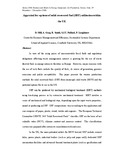JavaScript is disabled for your browser. Some features of this site may not work without it.
| dc.contributor.author | Hill, D. | - |
| dc.contributor.author | Garg, A. | - |
| dc.contributor.author | Smith, Richard | - |
| dc.contributor.author | Pollard, Simon J. T. | - |
| dc.contributor.author | Longhurst, Philip J. | - |
| dc.date.accessioned | 2011-09-29T17:33:11Z | |
| dc.date.available | 2011-09-29T17:33:11Z | |
| dc.date.issued | 2006-11-29T00:00:00Z | - |
| dc.identifier.citation | D. Hill, A. Garg, R. Smith, S.J.T Pollard, P.J. Longhurst, Appraisal for options of solid recovered fuel (SRF) utilisation within the UK, Venice 2006: Biomass and Waste to Energy Symposium. Cini Foundation, Venice, Italy. 29 November – 1 December 2006. | - |
| dc.identifier.uri | http://dspace.lib.cranfield.ac.uk/handle/1826/4122 | |
| dc.description.abstract | In view of the rising prices of non-renewable fossil fuels and regulatory obligations affecting waste management, interest is growing for the use of waste derived fuels in energy intensive facilities in Europe. However, major concerns with the use of such fuels include the quality of fuels, its source of generation, gaseous emissions and public acceptability. This paper presents the various production methods for solid recovered fuels (SRF) from municipal solid waste (MSW) and the potential options for its use in the UK. SRF can be produced by mechanical biological treatment (MBT) methods using bio-drying process or by extensive mechanical treatment. MBT involves a series of mechanical and biological steps, depending upon the input waste properties, aimed at producing an SRF. SRF compositions vary according to the application and can comprise of paper, plastic, wood, textile and organics. The European Technical Committee CEN/TC 343 “Solid Recovered Fuels” classifies SRF on the basis of net calorific value (NCV), chlorine content and mercury content. This classification system was prepared after extensive consultation with end-users. In the UK, the main potential outlets for MSW derived SRF include cement kilns, power plants, industrial boilers (such as pulp and paper mill), dedicated SRF incineration facilities and advanced thermal treatment plants (such as gasification and Venice 2006: Biomass and Waste to Energy Symposium. Cini Foundation, Venice, Italy. 29 November – 1 December 2006. pyrolysis). Cement kiln operators prefer high NCV fuel, however, in spite of its lower CV in comparison to other waste derived fuels (like liquid solvents, tyres and MBM), it remains attractive due to its biomass fraction and cheap availability. Power plants are much more concerned with the biomass fraction, as it may bring revenues for them in the form of Renewable Obligation Certificates (ROCs). Similarly, gasification and pyrolysis techniques are also eligible for ROCs, but these are still not fully proven in the UK. The use of SRF is also of interest because of its potential to reduce greenhouse gas emissions, as the biomass rich fraction is considered ‘carbon neutral’. Thus, this assists energy facilities to meet the EU Emissions Trading Scheme targets. However, the application of SRF is not straightforward as legislation exists at EU and National level, which users need to comply with. In addition, technical, environmental and economic issues need to be addressed. On the other hand if more SRF can be used then this will greatly help the UK meet its obligations under the Landfill Directive and the mitigation of greenhouse gases. | en_UK |
| dc.title | Appraisal for options of solid recovered fuel (SRF) utilisation within the UK | en_UK |
| dc.type | Conference paper | - |
Files in this item
This item appears in the following Collection(s)
-
Staff publications (SAS) [907]
